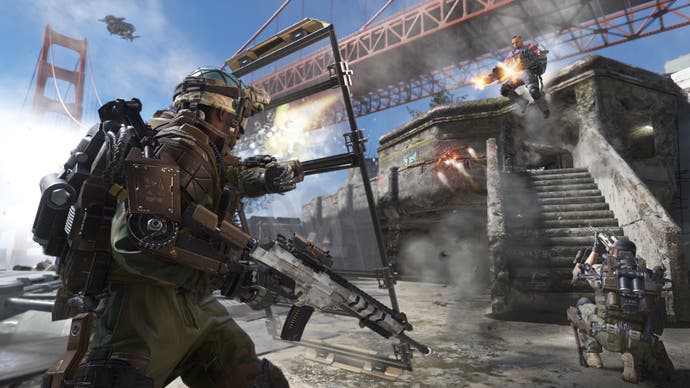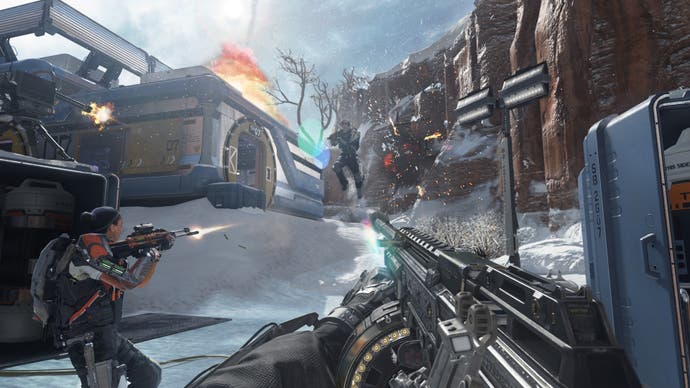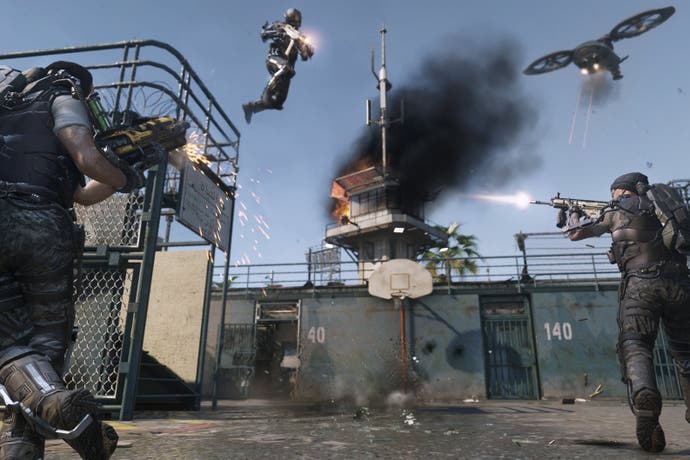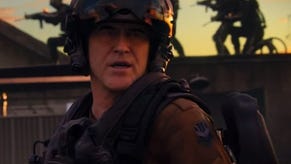Does Advanced Warfare's exoskeleton really change Call of Duty multiplayer?
Hands on with Sledgehammer's shot at the big time.
Call of Duty: Advanced Warfare's marketing tagline is "power changes everything". That's not just about Kevin Spacey's all-conquering private military corporation in the game's story. It's about the multiplayer, too.
More specifically, it's about mobility, that is, how your character moves about the map. Sledgehammer Games' take on the soldier of the future revolves around the exoskeleton, and what that does is give players what are in essence super powers.
And those powers change the way Call of Duty's multiplayer feels to play. Really, Advanced Warfare is the most promising shake-up the established fast and frenetic - and for some people tired - Call of Duty formula has enjoyed in recent memory.
The most obvious example of this is the boost, a sort of floaty double jump. You jump then jump again to get a boost farther into the air. But from there you can use the boost again to do a mid-air dodge, reverse or even speed forward. You can even slam down onto the ground and score a kill if there's someone underneath your boot.
All these movement abilities combined make Advanced Warfare's multiplayer something of a jerky ballet. Soldiers fly through the air elegantly, then while up there dart this way and that. The boosts are fast, responsive and a lot of fun to use.
They're also useful. You can make up a lot of ground by jumping, boosting, then boosting forward, so catching runaway enemies is easier. You can also get to flag carriers and, in the Uplink mode, the data carrier, quicker. There's an interesting ground game, too, that benefits from a dash move. Dashing helps you jump out of cover to fire down lanes and corridors, but it's best used as boost strafing to keep a moving enemy in your sights.
Adding to this are seven exo abilities, each limited in their use by your suit's battery power (there's a small icon that pops up showing the power drain as you use the abilities). Some are obvious in that they simply extend basic human abilities: Overclock makes you faster for a bit, and stim increases your health temporarily. Others involve fancy tech: Shield spawns a shield in front of you, Cloak does what it says on the tin, Hover lets you stay up in the air, Ping shows every exo movement and weapons fire on the map, and Trophy System destroys incoming grenades and rockets.
For Sledgehammer Games co-founders Michael Condrey and Glen Schofield, the exoskeleton is the foundation of Advanced Warfare's gameplay. It's also the hub from which all its new ideas spread.
"The exoskeleton is the key," Schofield says in an interview with Eurogamer. "We can hang anything on it. We can attach stuff to it. It is the heart and soul. We want you to fly. We want you to boost. We want you to do these things. And we can do them because that's what it allows you to do.
"Apple comes up with the iPad and then apps are created," he says. "That's what happened with the exoskeleton. And then we got boost jump. And then we were like, well what else can we do with it?"
All these boosts and abilities, then, force an unlearning when you first play Advanced Warfare. There's no need to stick to the ground. In fact, it's probably best not to. Jumping all over the place makes you harder to kill, and it's much easier to spot enemies from above than it is huddled behind cover.
The maps - at least the maps we've played - have been designed with the boost in mind. My favourite so far is Riot, a bombed out Baghdad prison. There's a cell block for traditional close quarters action, but there's also an open area outside with plenty of room for leaping over walls and down onto heads. Still working prison trackers shine lasers on soldiers, so outside there's nowhere to hide. The Biolab map is great, too. Inside the facility there's plenty of traditional Call of Duty action, but the snowy exterior is where you stretch your legs. There's loads of glass windows to smash, too, so you can boost jump, slam through a window and shotgun an enemy soldier without even touching the floor.
12 modes are available at launch. These include Capture the Flag, which works as you'd expect, Hardpoint, which is a moving king of the hill variant, Team Deathmatch, Domination and Search and Destroy. One brand new mode we played was Uplink, which sees both teams hunting a satellite drone. To score a point your team needs to pick up the data then chuck it in your floating uplink, the goal The Matrix would come up with if it was allowed to tinker with football.
Despite everything Advanced Warfare adds that is new, I wouldn't go as far as to say it revolutionises the first-person shooter genre. But for the Call of Duty franchise the game is a breath of fresh air. Condrey says this: "It is such a profound change to the movement set that it's going to set a whole new standard for how Call of Duty is played."
Condrey's prediction, I'm sure, is a good one, but Advanced Warfare's multiplayer still feels very Call of Duty in that it's lethal and blisteringly fast. If you get the drop on a guy and your aiming down sights isn't awful, more often than not you score a kill. But this is the case now, before Advanced Warfare is even out. Extended play will no doubt uncover ways to use the exo suit to escape situations that before would be fatal.

At first glance Advanced Warfare's multiplayer looks like Titanfall without the titans. This is a somewhat cheeky simplification, but the irony won't be lost on Respawn Entertainment, whose founders Jason West and Vince Zampella created Call of Duty while still employed by Activision. It's also not entirely true: actually Advanced Warfare has a mech: the X51 Goliath is a manually piloted suit of advanced armour with heavy weapons.
It's funny, boost jumps and flying all over the place are all the rage in first-person shooters right now. Titanfall turned heads with its wall-jumping. Each Guardian class in Bungie's Destiny has its own type of mid-air boost. And now Call of Duty joins the mile high club.
Of course, Sledgehammer insists it isn't copying anyone. Rather, the glut of double jumping first-person shooters is all a weird coincidence.
"Modern Warfare 3 was in the can," Schofield says. "It was going through certification and we were already thinking about this game. And that's when we first started talking about the Exo, three years ago."
And it's not just games, either. It's movies, too.
"Fans probably had the same feedback across the industry about wanting new ways to play first-person shooters," Condrey adds. "We hit on this on day one, long before we'd seen it in other games. It was our little secret sauce. And then within one year Oblivion came out, Elysium came out and Edge of Tomorrow came out, and all of a sudden Exo was in every holiday movie. I was like, wow. So, coincidence for certain because we came up with it on our own, but then all of a sudden boom, it's like mass pop culture, the exo is everywhere."
Neither Titanfall, Sledgehammer insists, nor anything competing video game, inspired Advanced Warfare. But I get the impression Treyarch's Call of Duty: Black Ops 2 certainly did. An example: Scorestreaks, introduced by Black Ops 2, are back, but improved. You can customise them with optional add-ons. So, you can replace the machine gun turret with a rocket, or rip the head off to carry it into battle. This increases the Scorestreak points cost, but adds extra depth to the pre-match strategy.
There are a number of Scorestreaks available. The most impressive we saw was the 1000 point Paladin, an orbiting gunship you can pilot. The X51 Goliath I mentioned above is another. There are even co-op Scorestreaks, with one avatar highlighting enemies from above while the other shoots them on the ground.
Another example: Treyarch's Pick 10 system has been appropriated as the Pick 13 system, which you use to equip your character with weapons, attachments, perks, Scorestreaks (in a first for the series you can have zero Scorestreaks up to four) and all the rest of it. The Hardpoint game mode we mentioned before was also introduced by Black Ops 2. So it comes as no surprise to hear Condrey say Black Ops 2, for him, was the best multiplayer offering ever in Call of Duty. Schofield echoes the sentiment: "In my household everybody's gone back to Black Ops 2," he says. "That's what we're playing now."
I remember thinking well of Black Ops 2, in that it had plenty of lovely little ideas that on their own didn't set the world on fire but collectively caught the eye. Advanced Warfare rekindles that memory. Take the Virtual Lobby, for example. Here, while waiting for the map to load, you can inspect highly detailed player avatars avatar. You'll want to check them out because of Advanced Warfare's loot system. After each match you get a Supply Drop, which is as close as Call of Duty gets to a loot chest. In this you might find a few items, categorised into three types of quality. The better quality the weapon, for example, the better its stats. It looks like somebody at Sledgehammer is a fan of Borderlands: I'm told with all in-game rewards on offer and the all new customisation suite there are more than two billion unique player combinations.
My favourite of Advanced Warfare's nice new ideas is the Virtual Firing Range. Before the next match starts you can press a button to instantly transport into a firing range in which you can test out your new gun. It's a brilliant idea that I expect more than a few developers will copy.

Everything about Advanced Warfare seems a step in the right direction after the misstep that was Call of Duty Ghosts. Where Ghosts felt like a bland stopgap as gamers switched from PlayStation 3 and Xbox 360 to PlayStation 4 and Xbox One, Advanced Warfare boosts forward with improved visuals. The game runs at a rock solid 60 frames per second, and while Condrey won't commit to a native resolution for either next-gen versions, he's already promising to beat Ghosts in this department.
"We're way ahead of where we were on Ghosts," he says. "We're doing some final optimisation right now. PR is not letting me commit exactly yet, and you'll know as soon as we know the final, but I can say we're well ahead of where Ghosts was at. We're targeting above what they did last year. The resolution news we'll have soon will make fans happy."
This is not to say Ghosts was a bad game. It was just banal, more of the same and lacking in new ideas (sorry Colin). Advanced Warfare feels fresh, benefiting from the energy that comes with a three year development cycle and a studio not bogged down by years of Call of Duty creation.
It's fair to say the gargantuan Call of Duty multiplayer community didn't take to Ghosts with quite the fervour they did Black Ops 2. Advanced Warfare should go down much better than its predecessor and for good reasons. Power, then, doesn't revolutionise shooters, but it sure changes Call of Duty.










